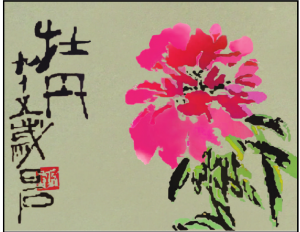
Digital copy of a painting (Peony Flower) – Image: Nature Communications
Scientists have developed a way of extracting a richer palette of colours from the available spectrum by harnessing disordered patterns inspired by nature that would typically be seen as black.
When surfaces appear black or white, however, it’s often because the nanoscale structures are completely disordered, causing all the light to be either absorbed or reflected.
A team of researchers led by the University of Birmingham has now found a way to control the way light passes through these disordered surfaces to produce vivid colours.
The team, which includes Stefan Maier from Ludwig Maximilian University of Munich, Germany, and Nanjing University in China, has compared the method to techniques that artists have exploited for centuries. Among the most famous examples of this is the fourth-century Roman Lycurgus Cup, made from glass that appears green when light shines on it from the front, but red when light shines through it from behind.
Please read the complete press release from the University of Birmingham.
Publication details: Mao et al (2020). ‘Manipulating disordered plasmonic systems by external cavity with transition from broadband absorption to reconfigurable reflection’. Nature Communications, 11, 1538 (2020)
